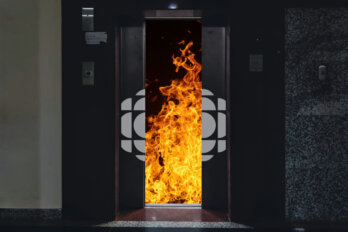What is the role of a journalist? It depends on who’s being asked, and the next of many answers could come from a superior court judge in British Columbia.
At issue: What was acclaimed photographer Amber Bracken doing in the Tiny House, a barricaded cabin on Wet’suwet’en territory, when police forced their way inside on Friday, November 19, 2021? They arrested Bracken, along with protesters and a documentary filmmaker, and held them all in custody for a weekend on charges of violating an injunction order that restricted access to a gas pipeline worksite. Bracken and The Narwhal, which had assigned her to cover the pipeline blockade, are now suing for wrongful arrest, arbitrary detention, and breach of the constitutionally protected freedom of the press. In court filings this fall, Bracken and The Narwhal stated that she was at the blockade “to document and observe the newsworthy events as they evolved.” The police responded that her “actions went beyond her role as a journalist.”
Bracken’s website describes her as interested in “the intersection of photography, journalism and public service” and representing Indigenous people’s empowerment and struggle for justice, which she seeks to “represent and foster.” So was she in the Tiny House that day as a journalist or as an advocate?
Or is it possible to be both?
The same question lay near the core of a lawsuit in the United States that settled in April this year. Dominion Voting Systems had sued Fox News over false allegations in Fox broadcasts and social media that Dominion had helped to steal the 2020 US presidential election from Donald Trump. Fox’s lawyers claimed that Sean Hannity and other prime-time hosts should benefit from legal protections available to US journalists. Until agreeing to a settlement in April for $787.5 million (US), Fox argued that the contested statements were “mixed opinion” and said it was fighting the case as part of a mission “to fiercely protect the free press.”
The right to promote unpopular opinions has been front and centre in fights against censorship for hundreds of years. “As an army’s safety rests in its sentinels,” Germaine de Staël Holstein wrote in her classic reflection on the French Revolution, “all rights depend on the freedom of the press.” Later years brought controversy over that freedom’s limits, but nowadays, digital disruption and the perils of disinformation have brought into focus a new question: Who exactly is “the press”?
Theoretically, anyone can disseminate information on matters of public interest, in some cases with legal “press” status, which allows them to keep the secrets of confidential sources, to gain access, in some cases, to reserved spaces, and to benefit from taxpayer-funded subsidies.
Not all who claim such breaks win them. In February 2022, the Canada Revenue Agency denied the overtly-right-wing Rebel News site tax status as a qualified journalism organization after an expert panel found the site’s content to be “largely opinion-based and focused on the promotion of one particular perspective.” For similar reasons, the federal commission that runs party leaders’ election debates has twice denied press accreditation to Rebel News. Both times, the Federal Court of Canada overruled the commission, seeing no inherent contradiction between advocacy and the privileges of a free press. As one judge noted, the Toronto Star lists social change as part of its core mission.
At face value, the idea of legally privileging journalism is anachronistic in the digital age. Campaigners for an unfettered social information web—including some journalists themselves—see state funding of newsrooms as an offence against the principle of press freedom. Under this rubric, laws such as this year’s Online News Act seem, at best, a waste of time and money that inevitably earned the ire of tech giants and led to Meta throttling access to independent Canadian news.
From this perspective, the entire internet is now “the press,” whose freedom should be guaranteed, not constrained, by the state. If its Wild West economics shutter traditional newsrooms, that’s on publishers who hew to unsustainable business models. As for information disorder, that huge problem is down to bad actors exploiting and stoking cultural and political polarization, audiences’ increasing interest in standpoint-centred commentary, and people’s declining willingness to trust anything purporting to be “bare facts” about current affairs (aka news).
Whatever one thinks of the arguments around protecting the “press,” it’s clear that the reporters and purveyors of news face a sustainability crisis from which relatively few seem likely to recover.
That, at least, is the pessimistic view from Canada and other English-speaking countries, where both publishers and audiences of news seem tied to assumptions about the culture, norms, and business approaches that developed around a century ago. But there are places in the world where greater optimism has been built on strikingly different approaches to journalists’ independence, obligations, and accountability. In some of the world’s healthiest democracies, news audiences continue to respect truthful news reporting, to expect meaningful journalistic accountability, and, yes, even to pay for online news.
No world region seems to provide more cause for optimism about journalism and a healthy public information system than the group of Nordic countries which have long been widely recognized as fostering exemplary journalism while leading the world when it comes to press freedom. And even against such midnight-sun brilliance, the reputation of one country seems to shine as a nurturer of political and media freedom and of social peace—which is why last year, while researching my book on freedom of the press globally, I spent a little time in Norway.
“Have you ever heard of news deserts?”
Sigurd Haugsgjerd had been politely, unflappably candid since I arrived (late, flustered, sleep deprived by the persistent June sun) for morning coffee, and his bright blue eyes did not blink now.
“Nei,” he said. “What’s that?”
Nothing, it seemed, like the village of Bygland or the other rural communities squeezed between blue-white water and steep granite cliffs in the southern Norwegian valley called Setesdal. The area gets regional news out of the coastal city of Kristiansand, population approximately 116,000. It’s home to several public and private TV and radio stations plus a fist-thick daily paper, Fædrelandsvennen, that, at the time of my visit, boasted 35,000 subscribers and employed fifty-five unionized journalists amongst a staff of around 100. In Canada, a paper with an equivalent-sized target audience would be lucky to employ half as many journalists; a community newspaper will close somewhere in our country within the next two weeks or so, if a recent years’ trend persists.
Setesdal gets more strictly local news from Setesdølen, the community paper that Haugsgjerd edits out of a six-room office. Its two weekly editions together offer about twenty-four news pages, mostly dominated by photos of community members at community and sports events. Every confirmation service in every parish is marked by a photo as a matter of editorial policy. And then there’s local politics, local business, the occasional fire or crime. The editor writes a short, acerbic weekly column that betrays no hesitance about calling out business, political, and religious leaders for what he considers unfair decisions, intolerant positions, or insufficient attention to the valley’s best interests.
Reporter Olav Haugsgjerd sat in on my interview with his dad and boss to translate and fill in details, such as when I asked about current circulation. Consulting his phone, he said the paper reached 3,411 subscribers, and 486 more paid for digital access only.
And the valley’s population? Roughly 6,000, Olav said, from memory, “including everyone from retirement home to kindergarten, so probably about 2,000 households.”
“Wait,” I said. “That’s . . .”
Yes: twice as many subscriptions as households. Many people, Sigurd explained, “move away and want to stay in touch with their home. And the tourists [city-living weekenders] subscribe as well.” The paper is delivered as far away as Oslo. “A lady from the retirement home comes to pick up a copy and reads it aloud for the people who have bad eyesight.”
Not a news desert, then.
Here, you might sigh: Ah, but that’s Norway. It’s true that Nordic countries sit routinely, and (if we’re honest) annoyingly, atop almost every international index of health and happiness. And wealth wise, yes, Norway’s oil provides top-ten prosperity, which helps pay for expensive goods, such as journalism.
But neither wealth nor happiness seems adequate to explain the trend-defying high news readership in every Norwegian age group, or that 39 percent of Norwegian online news consumers said, when surveyed for this year’s Reuters Institute Digital News Report, that they paid for online news content. (Swedes were second at 33 percent, with all other surveyed countries well below 20 percent. Canada is at 11 percent, with no difference between the two official-language groups.)
Advertising follows eyeballs, and the hour I spent with Setesdølen’s back issues suggested little change over the decades in advertising content: full pages offering cars and farm equipment, and stacked display ads. The ads come steadily, it seems, despite the paper’s history of exposing business influence on local politics, sometimes illustrated by cartoons showing variations on a theme of overweight money bag holders kicking mayors’ hindquarters.
I asked Sigurd Haugsgjerd if businesses sometimes withdraw advertising to protest against his paper’s reporting.
“Nei,” he said, smiling.
I pressed. Truly? Not once, in nearly five decades?
“Nei.”
But sometimes such a thing is threatened?
“Nei, nei.”
“What do you make of that?” I asked finally.
The editor gazed down, for a moment or two, at the desk between us, and then he almost winked as he said, in English: “Maybe we haven’t been tough enough.”
It’s far from uncommon, in most countries, for advertisers, sponsors, political figures, and well-placed friends of editors and publishers—let alone the owners of news businesses—to retain influence over editorial direction, however discreetly this may be exercised. Indeed, shareholders might be forgiven for arguing that deciding what’s published under titles they own is part of what it means to enjoy freedom of the press.
The argument is plausible, but it confuses the modern meaning of press freedom with that of freedom of speech. These two related constitutional liberties are more clearly distinct with respect to news gathering than to its publication. According to UNESCO, news media freedom implies more than the mere absence of “control, censorship, or harassment” by the state; it also requires several positive protections of journalists’ professional practice involving source confidentiality, libel defences, special access to information, an “enabling environment” of news pluralism, plus carefully constructed measures to support news media viability and pluralism without compromising independence.
Digital disruption of traditional news business models has made such an “enabling environment” for a free press ever harder to imagine without the active assistance of public policy. But is it fair to expect public support and legal privileges without granting a countervailing expectation—that journalists should actively regulate their own and one another’s practice according to peer-approved professional standards?
In many national settings, proposals to ground professional integrity in formally monitored professional standards present a can of worms. The Nordic countries open that can by expecting editors and publishers to submit to muscular press councils’ adjudicating authority over norms based on a shared commitment to public service.
The word “professional” has broad connotations, and in some journalistic milieux, varieties of the p-word elicit suspicion. I’ve met several respected journalists who prefer to speak of their work as a “craft,” not a profession, because of a wide resistance in many news cultures to any hint of self-regulation. Many journalists are, by nature, “non-belongers,” a lifetime union leader once told me, and they especially resist conformity with what they see as rigid expectations. Many seem too self-consciously individualistic to accept being bossed around—even by peers, in the name of common ideals.
Professionalism’s potential benefits include job security, labour standards, and journalistic autonomy, but perceived risks include retarding ethical conduct. Journalists in liberal regimes may consider professionalization a slippery slope to state certification. As well, the breadth of journalists’ work presents practical challenges to formulating common standards. Specific demands are made of reporters, editors, commentators, audience participation specialists, photojournalists, and those expected to energize followers by enlarging their online personalities. A business reporter is obliged to take precautions around influencing markets, and a cartoonist to avoid stereotypes. Moment-by-moment online journalism typically operates to different expectations of, for example, comprehensiveness and correctability. A major news organization employs layers of editors to manage hundreds of reporters; the local owner of a radio station, news blog, or community paper may have fewer staff than thumbs.
In so wide-ranging a field of journalistic work, is meaningful professional accountability even possible? That was one of the questions that had drawn me to Setesdal.
“Church minister fired.”
The headline was straightforwardly factual, but this latest story on a continuing minor scandal was the last straw for upset lay leaders in the church at Valle, upriver from Bygland. They complained to the Norwegian press council about the entire thrust of Setesdølen’s coverage of a local dispute in spring 2021, starting with a venue disagreement over a confirmation service during the COVID-19 pandemic.
As Sigurd Haugsgjerd’s editorials made clear, he believed a veteran church worker had been unfairly punished for outspoken criticism of her employers. “They have frozen out enthusiastic and creative employees before,” said one column. Repeated use of the term “church circus” [kyrkjesirkus] did little to assuage the umbrage.
Haugsgjerd is an active Christian, a member of his own parish council who nevertheless prefers to walk the hills with his bird dogs most Sundays. He told me he once said this to an archbishop: “I respect the Lord more than I respect his ambassadors.”
Haugsgjerd launched his journalistic career at the age of sixteen, with a report on local overfishing practices published in a Bergen paper. As editor of Setesdølen, he once ran a front page that featured a picture of an incumbent mayor under the headline “What has this man accomplished?”—with the clear implication: not much. Fellow journalists in the south describe him as a “living legend,” but that didn’t get him a free pass with the Norwegian press council. The adjudicating panel found nothing objectionable in editorial comments but found Setesdølen’s reporting on the controversy to be “consistently tendentious.” In particular, the firing story failed to mention that the parish council had been approached for comment—an infringement of clause 4.14 of the national press ethics code.
As required by the country’s press association, the judgment was posted in full on Setesdølen’s website. A print story summarized the ruling straight up, with only the headline betraying Haugsgjerd’s edge: “Setesdølen’s church circus toppled at press council.”
Press councils exist in many countries, usually funded entirely by newspapers’ membership fees. Canada boasted several provincially based councils until national consolidation of publications’ ownership and content chipped away at their sustainability and moral authority. A decade ago, when the late John Honderich urged me to lead a consultation on the system, reactions were mixed. Journalists’ eyes glazed but publishers welcomed our report’s recommended creation of what is now the National NewsMedia Council (whose 500-plus members include The Walrus). Publishers like the idea of press councils because they provide an alternative to lawsuits when people have complaints. And voluntary accountability could help oppose political moves toward legally mandated self-regulation. (When the latter idea was promoted in Britain and Australia, its backers were accused of promoting something like—or, in the case of an Australian news executive, literally like—Stalinism.)
Norway’s system doesn’t legally require a publication to join the national press council, but all except a few rogue owners, editors, and journalists willingly join their respective unions and, by doing so, constrain their practices according to the council’s interpretation of a code of press ethics whose first version is older than the United Nations. Editors and publishers likewise must affirm a joint declaration of editorial autonomy, first agreed upon in 1953. Even more unusually, editorial autonomy is enshrined in a Norwegian law that states: “The publisher, owner or other company management cannot instruct or overrule the editor on editorial issues, nor can they demand to see print, text or pictures, or demand to hear or see programme material before it is made available to the public.” The law specifically forbids any agreement to deviate from this stricture, “except to the advantage of the editor.”
Once a year, the Oxford-based Reuters Institute surveys digital news audiences in selected markets (currently forty-six countries) about online news. The most basic statement is: “I trust most news most of the time.” Most respondents in most countries, including Canada, disagreed with this statement. In Canada, the trust level has declined from 55 percent (in 2016) to 40 percent (in 2023, the current world average) over the past seven surveys. The United Kingdom’s score has declined by 18 percentage points, in that period, to 33 percent, which is roughly equal to that in the United States and France. The lower levels of trust in news often, but not always, mirror reduced trust in institutions generally.
(A national aggregate showing overall distrust in “the media,” as people often call journalism, may easily veil successes that go against the tide. Public broadcasters, for example, exceed 80 percent trust scores in many democracies, as do some leading privately owned competitors. Canadians’ most trusted news sources, at almost 60 percent each, are our big three national TV networks and various local newspapers; Americans’ highest rating, in 2022, went to the UK-based BBC News.)
People in countries where news is trusted least are also most likely to say news is influenced by politics, business interests, or both. But when a research team interviewed separate groups of those who do and those who don’t trust the news in four countries, their different explanations were enlightening.
The “high-trust” interviewees claimed to consider the following in their news preferences: in-depth coverage, impartiality about controversial topics, asking hard questions, a record of reliability over time, transparency about sources, correction of mistakes, and disclosure of conflict of interests. That’s a surprisingly old-fashioned list to draw from a study fielded in 2021. More déjà vu: countries with high-trust scores are also those where people are most inclined to pay for digital news.
All this suggests that news publishers seeking both credibility and profitability might be relying too much on government help and promoting their brands’ trustworthiness. (As the saying goes: “Never trust a man who says ‘Trust me.’”) Instead, they may need to invest in the kind of journalism that earns trust in the hardest and most recognizable way—through consistent and transparent original gathering and transparent checking of actual facts on matters of clear public interest. Fact checking is a definitionally essential ingredient of responsible journalism, but it is haphazardly practised, labour intensive, and expensive. Punditry, of course, is the cheapest, and though it attracts clicks, and therefore advertising revenue, it can’t justify a news organization’s claim for public support or legal entitlements under the heading of press freedom.
When right-wing populists raised the threshold of lies about electoral gains in the United States in 2016 and Germany in 2020 by impugning the reliability of elites, including news media, some journalists shifted into attack mode, fiercely playing up voters’ biases or rebelling against journalistic norms regarding neutrality and newsworthiness. Since, as things turned out, these tactics have done nothing to restore public faith in news media, it may be worth listening a bit harder to what news consumers say they want and what they are willing to pay for, given the chance: robust, reliable, professionalism.
For most Canadian news media, this would demand a cultural shift. It involves owners ceding autonomy to editors, editors recognizing journalists’ quality concerns as labour rights, and all regular editorial contributors being emboldened by job security. It also involves journalists accepting accountability to peers’ judgment; those averse to joining professional associations may need to get over themselves.
At Pressens Hus, in Oslo, which houses the national councils of journalists, editors, and media owners, I met Elin Floberghagen, secretary-general of the confederate association that represents all these bodies. I asked her how these often-competing constituencies could have agreed on effective and legally buttressed self-regulation, evidently without surrendering their various principles, their competing interests, or the trust of their shared audiences.
“We talked,” she replied. “For a hundred years.”
Portions of this article are adapted from Ivor Shapiro’s book The Disputed Freedoms of a Disrupted Press, published by Routledge in July 2023.




